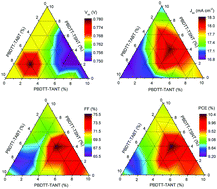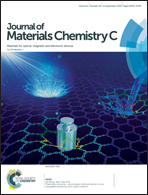Highly efficient polymer solar cells via multiple cascade energy level engineering†
Abstract
In this work, we demonstrate the first successful multiple blend polymer solar cells (PSCs) via a multiple cascade energy level alignment strategy which also have more efficient energy transfer pathways. Based on a pristine poly{4,8-bis[(2-ethylhexyl)oxy]benzo[1,2-b:4,5-b′]dithiophene-2,6-diyl-alt-3-fluoro-2-[(2-ethylhexyl)carbonyl]thieno[3,4-b]thiophene-4,6-diyl} (PTB7) and [6,6]-phenyl-C71-butyric acid methyl ester (PC71BM) binary blend, a series of two-dimensional (2D) conjugated benzodithiophene-thiophene copolymers (PBDTT-TABT, PBDTT-TANT and PBDTT-TSNT) were used as additional polymeric additives to finely tune the energy levels, absorption, crystallinity, carrier mobility and morphology of the studied active layer in PSCs. These ternary blends provided more charge and energy transfer channels for improving the photon harvesting, exciton dissociation and carrier transport, giving rise to improved device performances. After adding 10 wt% of these polymeric additives, power conversion efficiencies (PCEs) of 8.96%, 9.35% and 9.18% were achieved for PBDTT-TABT-, PBDTT-TANT- and PBDTT-TSNT-based ternary devices, respectively. By introducing a greater number of different bandgap copolymers with similar molecular backbones, steadier energy level alignment and more charge transfer channels were formed in the devices, without destroying the compatibility and morphology of the active layer, and this could promote further charge transfer more smoothly than the respective binary and ternary PSCs. When 4 wt% PBDTT-TANT, 4 wt% PBDTT-TSNT and 2 wt% PBDTT-TABT were added into the pristine PTB7:PC71BM blend, the multiple blend PSCs exhibited the highest PCE of 10.40%, which is the best value for PTB7-based PSCs reported so far. Our work demonstrates a facile design strategy via multiple blend engineering to increase open circuit voltage (Voc), short circuit current density (Jsc) and fill factor (FF) simultaneously to achieve high-performance PSCs.



 Please wait while we load your content...
Please wait while we load your content...